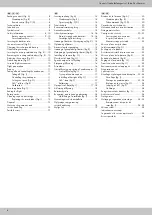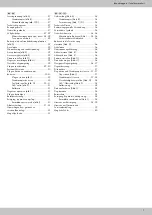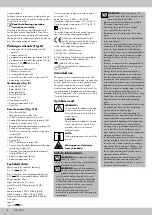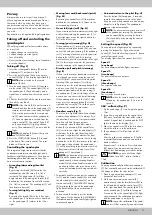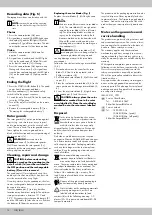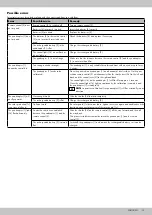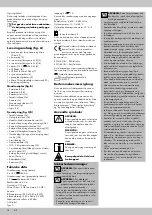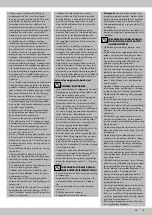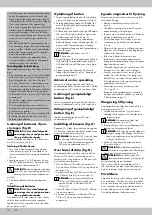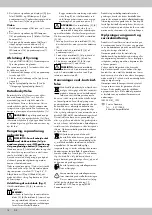
9
GB/IE/NI
• Select a suitable location (open space) to
operate the quadcopter. Flying over the fol-
lowing areas is prohibited, and a distance of
100m from these areas must be maintained:
crowded areas; accident sites, catastrophe
areas and other areas where public author-
ities and organisations are engaged in
security/safety activities; over mobile federal
army installations and troops conducting
announced manoeuvres and military exer-
cises; nature conservation areas; residential
areas; industrial plants; penal institutions;
involuntary treatment facilities; military instal-
lations and organisations; power generation
and distribution infrastructure; facilities in
which Protection Level 4 work requiring prior
authorisation under the Ordinance on Bio-
logical Substances is carried out, unless the
facility operator has given express permission;
hospitals; federal highways; federal water-
ways; railway infrastructure; state and federal
constitutional bodies or supreme or higher
state or federal authorities; embassies and
consulates; international organisations that
are located in an area based on international
law; and police property and property of the
security agencies.
Flight over the following areas is prohibited,
and a distance of 1.5km from these areas
must be maintained: airports, airfield control
zones, state and military buildings. Local flight
exclusion zones must be checked before each
flight.
• The quadcopter has been designed for use
by laypeople as well as experienced/trained
users. Users with sight or hearing impairments
must only use the quadcopter under the super-
vision of those without impairments.
The user’s reactive capacity must not be
compromised: tiredness, and the influence of
alcohol or medication can lead to incorrect
responses.
Additional skills are not required (e.g. train-
ing). There are no operating restrictions based
on gender or left/right-handedness.
• Never fly the quadcopter directly at other
people, animals or yourself.
• The motor, electronics and rechargeable
battery can heat up while the quadcopter is
in operation. For this reason, take a break of
5–10 minutes before recharging the battery
or installing another previously charged
battery.
• Improper operation can cause serious per-
sonal injury and damage to property!
For this reason, make sure that you maintain a
safe distance from other people, animals and
objects when flying.
• Always leave the remote control switched on
while the quadcopter is in operation.
Switch the quadcopter off after landing it. The
remote control can then be switched off.
• In the event of a fault or a malfunction, the
cause of the defect must first be resolved
before you restart the quadcopter.
• Do not expose the quadcopter or the remote
control to direct sunlight or high temperatures
for extended time periods.
• In the event of a serious crash (for example,
from a great height), the calibration may be
damaged or detuned. It is therefore imperative
that complete functionality is checked before
a new flight!
• In the event of a crash, the throttle must be
brought down to zero immediately. Rotating
rotors can be damaged during contact with
obstacles or on impact. Before a new flight,
always check them for possible cracks or
breakages!
• In order to prevent damage to the quadcop-
ter from crashing due to under-voltage, or
to the battery due to complete discharge,
always keep a close eye on the under-voltage
indicator lights (see section on “Under-voltage
warning”).
• In some countries, insurance is mandatory
for model aircraft and model helicopters
which are flown outdoors. Please consult your
personal liability insurer and ensure that your
quadcopter is included in this insurance.
• Always make sure to respect the privacy of
other people and animals around you. Do not
film people close up unless they have given
you permission to do so. Note also that it is
not always permitted to film wherever and
whenever you wish. Pay attention to the appli-
cable legal regulations.
Battery warning notices!
GENERAL WARNING NOTICES
• Always keep batteries out of reach of children.
• Cleaning and maintenance must not be car-
ried out by children without supervision.
• When necessary, clean the battery and
device contacts with a clean, dry cloth.
• Do not expose the batteries to extreme condi-
tions (e.g. radiators or direct sunlight).
• Handle damaged or leaking batteries with
extreme caution and dispose of them properly
as soon as possible. Wear gloves when doing
so.
• If you come into contact with battery acid,
wash the affected area with soap and water.
If battery acid gets in your eye, rinse with
water and seek medical attention immedi-
ately!
• Batteries must not be swallowed! However,
if this does happen, you must see a doctor
immediately!
• Never throw batteries into fire or put them
on hot surfaces (e.g., a radiator or a stove).
Never open the battery casing or the foil or
short-circuit the contacts. There is a risk of fire
or explosion!
• Avoid external mechanical influences (e.g.
blows, sharp objects or crushing). There is a
risk of fire or explosion!
• Do not expose the batteries or the recharge-
able battery to temperatures below 10°C or
over 45°C.
ADDITIONAL BATTERY WARNING
NOTICES (REMOTE CONTROL)
• Only use batteries from the same manufac-
turer and of the same type.
• Remove the batteries when they are flat, or
if the product is not in use for an extended
period.
• New and used batteries must not be used
together.
• Replace all batteries at the same time.
• Non-rechargeable batteries must not be
charged.
•
Warning:
batteries must not be charged
or reactivated by other means, taken apart,
thrown into fire, or short-circuited. There is a
risk of fire or explosion!
• Pay attention to the correct polarity (+/-) when
inserting the batteries.
• Dispose of used batteries properly at munici-
pal collection points or in shops.
ADDITIONAL WARNINGS FOR
RECHARGEABLE BATTERY (QUAD-
COPTER)
• Never leave batteries charging unattended.
• Never charge the rechargeable battery imme-
diately after use. Always allow the battery to
cool down first (min. 5–10 minutes).
• Only use the USB cable provided to charge
the battery.
• Only charge intact and undamaged recharge-
able batteries. If the outer insulation of the
rechargeable battery is damaged or if the
battery is deformed or bloated, it must not be
charged under any circumstances. In this case,
there is an extreme risk of fire and explosion!
• Since both the USB cable and the battery
heat up during the charging process, it is vital
to ensure there is adequate ventilation. Never
cover the USB cable or the battery!
• Disconnect the battery from the USB cable
when it is fully charged.
• Never charge or store the rechargeable
battery near large heat sources or open fires,
as this could result in a fire or an explosion.
• Do not leave the rechargeable battery
unattended while charging, and watch out for
possible overheating of the battery.
• Never charge a battery that has expanded as
a result of overheating, dropping or over-
charging.
• Never charge a battery that is punctured or
damaged. Examine the battery very closely
for such damage if it has been dropped. If the
rechargeable battery is damaged, dispose of
it according to the regulations in your country.
• If the rechargeable battery catches fire during
the charging process, extinguish this type of
rechargeable battery with plenty of water.
• The USB cable must only be used in dry,
enclosed indoor areas. The USB cable and
rechargeable battery must not get damp or
wet.
• Never short-circuit the battery. There is a risk
of fire or explosion.
• Never carry rechargeable batteries in trouser
pockets or carry bags. Watch out for sharp
or angular objects which could damage your
rechargeable battery.
• If the rechargeable battery has been sub-
jected to a strong impact, store it in a very
secure place (e.g. in a metal box) for the
next 30 minutes. Pay attention to whether
the rechargeable battery expands and/or
overheats.
• Never try to manipulate, modify or repair the
rechargeable battery.




